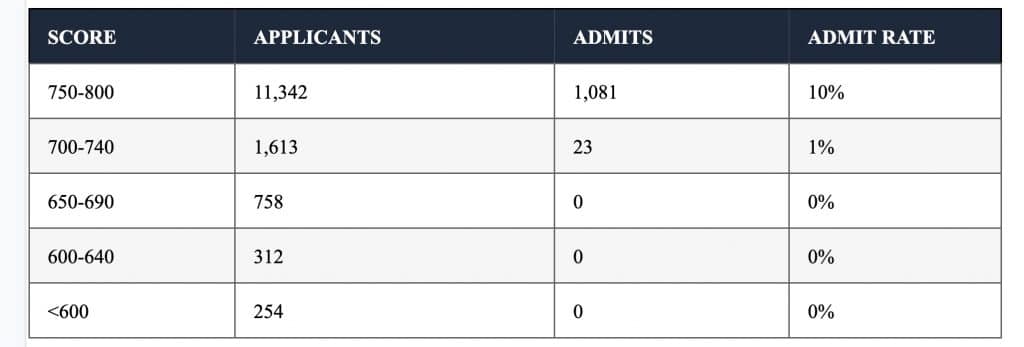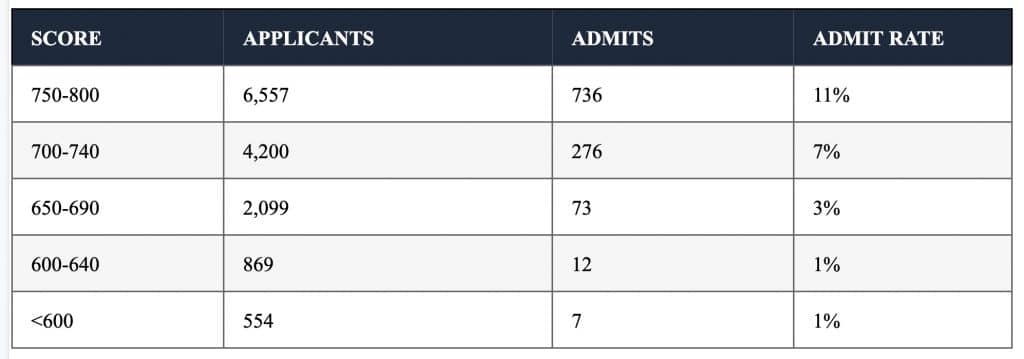What is the Average SAT Score at MIT?
When it comes to the most prestigious and selective universities and colleges in the United States, there is little doubt that the Massachusetts Institute of Technology – or MIT as it is commonly known – is amongst the very best.
If you are a high school student who is hoping to one day attend MIT as an undergraduate student, there is little doubt that you are asking the question, “What is the average SAT score at MIT?”
At AdmissionSight, we make it our top priority to help the fantastic high school students that we work with every application cycle get into the school of their dreams.
Unsurprisingly, MIT is at the top of many students’ lists, along with the eight schools in the Ivy League as well as other top schools elsewhere in the United States such as Stanford and the University of Chicago.
When it comes to high school students managing to get into schools like those previously mentioned, students not only have to have fantastic grade point averages, standardized test scores, and achievements outside of the classroom, they also have to have a lot of knowledge about how the admissions process at top schools works and what admissions officers are looking for. That’s where we come in!
So, if you are curious about the MIT typical SAT scores, the MIT acceptance rate and other MIT requirements, then you have come to the right place. Let’s get started.
MIT’s average SAT score
For years, the SAT, and the other standardized test in the United States, the ACT, have played crucial roles in the entire admissions process.
In fact, the SAT and ACT have long been regarded as the second most important factor to a student’s ability to get into a top school behind their grade point average.
This has changed quite a bit in recent years, but we will get into that a little later on. For now, we simply want to break down the average SAT score for students that get into MIT.
When it comes to the average of MIT SAT scores for students that get into the school, the score is a jaw-dropping 1535 out of the perfect score of 1600.
The 25th percentile score for students that get in is 1500 (a score that would help a student get into just about any of the Ivy League schools), and the 75th percentile score is the near-perfect score of 1570.
An average score of 1535 is shockingly high. In fact, it is one of the highest school averages that we have found when it comes to researching and learning about the typical SAT scores for students who get into top schools. It is one important indicator of just how competitive of a school MIT really is.
Furthermore, here is a deep dive into the breakdowns of the scores that students earn who end up applying to MIT.
Distribution of SAT scores (Math)
Distribution of SAT scores (ERW)
Now that you do know the answer to the question, “What is the average SAT score at MIT?”, it is also very important that you are up to date on the latest changes to the standardized test policy at MIT.
In fact, MIT is just one of countless schools that have adopted a standardized test optional policy. That means that students are now able to send in their completed application without taking either the SAT or ACT.
This trend began several years ago as some began to question the efficacy of the standardized test process. However, it has really come into major popularity as a result of the ongoing COVID-19 pandemic.
As students turned to remote learning and entire cities shut down, admissions committees across the country knew that it simply could not ask students to put their health at risk in order to take the SAT or ACT. Here is what MIT has to say about its current standardized test policy.
“Due to the COVID-19 pandemic, our office will continue to suspend our usual SAT/ACT testing requirement for the 2021–22 application cycle,” the school announced. “You can learn more about this decision here.
Updated requirements
- “We will not require the SAT or the ACT from first-year applicants applying in fall 2021, or transfer applicants applying in either fall 2021 or spring 2022
- “Students who have already taken the SAT/ACT, or who can find a forthcoming opportunity to do so safely are encouraged to submit their scores with the understanding that they help us more accurately evaluate their preparedness for MIT.
- “Students who have not already taken the SAT/ACT, and cannot find a forthcoming opportunity to do so safely are discouraged from taking the test, in order to protect their personal health, as well as the health of their family and community. We will not make any negative presumptions regarding academic preparation based solely on the absence of SAT/ACT scores, but will instead make the best, most informed decision we can by rigorously assessing other academic aspects of their application (such as grades, coursework, and other examinations).”
With that being said, MIT does still leave students the option to self-report their SAT or ACT scores.
“Going forward, we will no longer be requiring applicants to officially send their SAT, ACT, or English proficiency test scores as part of their application,” the school announced. “Instead, they will be able to self-report their scores on the application, and we will verify these scores upon enrollment.
There will be an opportunity to update us with any test results that become available after an application is submitted. We accept test results from any test taken before November 30 for Early Action applicants, and any test taken before December 31 for Regular Action applicants.
We will also accept English language proficiency test scores for RA applicants through the January test dates.”
So what does this mean for high school students who are committed to giving themselves the best chance possible at getting into a school like MIT? Well, the truth is that it depends on who you ask. It also depends on your concerns as they relate to the ongoing COVID-19 pandemic.
Essentially, if you feel that you are able to take the SAT or the ACT in a safe way that will not put you or anyone in your life at risk of contracting the virus, you could absolutely help improve your case to get into MIT.
While students who do send in scores will be given no official advantage, it is still quite clear how sending in a test score could help you.
Essentially, the entire admissions process is just admissions officers trying to determine which students would be the best fit at a school from an academic and cultural standpoint.
If you are able to earn a great score on the SAT, one that is even ideally higher than the MIT typical SAT scores, then there is no doubt that you will be giving your application a nice boost!
MIT acceptance rate
Now that we have broken MIT average SAT as well as the current MT requirements – or rather lack thereof – when it comes to standardized testing these days, we thought that it would be a good idea to break down the basics when it comes to the all important MIT acceptance rate.
On top of that, we will also quickly go over the acceptance rates at all eight Ivy League schools, so you can get a better idea of how MIT stacks up against some of the most prestigious schools in the United States.
Currently, the general acceptance rate at MIT for the 2025 graduating class was just 4.1 percent. If you are curious about how the MIT acceptance rate compares to the acceptance rates at the schools in the Ivy League, take a look at the acceptance rates below:
- Columbia – 3.9 percent
- Harvard – 4.0 percent
- Princeton – 4.0 percent
- Yale – 4.6 percent
- Brown – 5.5 percent
- Penn – 5.9 percent
- Dartmouth – 6.2 percent
- Cornell – 8.7 percent
As you can see, MIT is right in line with the Ivy League when it comes to selectiveness. Moreover, in the minds of many, MIT even exceeds the Ivy League when it comes to level of prestige.
How to improve your chances of getting into MIT
There is no sugar coating it, getting into MIT is a Herculean task for even the most impressive and accomplished high school students.
After all, MIT has taught and helped mode some of the most important and influential minds in the fields of math, science, engineering, business and beyond. As the school is intent on maintaining and even increasing its prestige, it makes sure that only the most deserving students end up getting in.
So while there is truly no way for any student to truly guarantee their admission into MIT, there are important ways in which any student can improve those chances. At AdmissionSight, we believe that any student can improve their chances of getting into the top schools in the United States by following these key tips.
Let’s get into it.
Craft meaningful personal essays
When students are applying to schools in the U.S., they are expected to answer a number of personal essays.
The number of questions that a student has to answer, as well as what the specific questions are depend on the schools that the student is applying to. However, all personal essays are geared towards getting to the bottom of one key question:
“Who are you, and what do you value?”
When it comes to MIT specifically, the school requires that all students answer a series of short prompts with the goal of getting the student the chance to answer that basic question above in their own words.
The personal essay section is really about allowing a student to show who they are beyond their great grades, test score and extracurriculars.
Truth be told, with the current state of the importance of the SAT and ACT in the application process in flux, there are many experts within the admissions world that now consider the personal essay section to be the second most important aspect of any student’s application behind only their grade point average.
Considering the fact that a student’s GPA is compiled over four years of hard work in the classroom and the essay section takes at most a couple months to complete, the weight that they carry in the entire process should be quite clear.
Now is not the time to try to give the admissions officers what you think they want to hear. Instead, you should be focusing on trying to understand and accurately depict your core beliefs, your passions, your goals, and how all those important aspects of your life have led you to believing that MIT is the school where you want to spend your undergraduate education at.
Keep it personal, make it clear, and make sure to give yourself the time that you need to review, edit and improve your answers before you send them into the MIT admissions office.
Get involved in rigorous academic competitions for your extracurriculars
One of the really important MIT requirements that any student should be thinking about as they start plotting out their plan to get into a school like MIT are the kinds of extracurricular activities that a student chooses to get involved in.
While MIT does not necessarily rank one kind of extracurricular over another kind, one of the best ways for a high school student to prove that they are constantly looking for rigorous challenges and exciting opportunities is to get involved in academic competitions.
Some of the most highly regarded academic competitions that you can get involved in during high school, earn a leadership position in and even – potentially win awards for – include:
- Academic Decathlon
- Academic Decathlon: Individual Competition
- Conrad Spirit of Innovation Challenge
- Davidson Fellows
- Destination ImagiNation
- National Academic Championship – Questions Unlimited
- National Academic League
- Odyssey of the Mind
- Quiz Bowl Tournament of Champions
- Stemanities Research Competition
- University Interscholastic League
- Science Olympiad
Of course, there are many other competitions that you can get involved in, and the most important thing is that you follow your passions!
Earn powerful letters of recommendation
Another really great way for any high school student to improve their chances of getting into the school that sits at the top of their list is to prioritize getting really strong letters of recommendation from the faculty at their high school.
MIT’s specific rules regarding the letters of recommendation portion of the application can be taken as a strong signal that the school takes these letters strongly into consideration when admissions officers are making their decisions. To apply to MIT, every student must get one recommendation letter from a science or math teacher and one from a humanities teacher.
When it comes to choosing which teachers you should be asking, it is always wise to prioritize asking teachers who you have taken a rather large number of classes with.
That way, you can be sure that they will know who you are not just as a student, but also as a person. They will know how to talk about your strengths as a leader in the classroom and as someone who expresses their passion in academics.
On top of that, you will want to make sure that you give the teachers who you want to write your letters ample time to actually craft the letters themselves.
Typically, students who know the vital importance of these letters will ask the teachers who they want to write their letters at the end of their junior year of high school, over the summer between their junior and senior years, or at the very latest, at the very beginning of their senior year. This will ensure that the teacher has the bandwidth to give the letters the attention that they deserve.
Will you get into MIT?
There is no clear way to get into MIT. Truthfully, the students that get into this school each and every year are amongst the most impressive students in the world.
The MIT acceptance rate currently sits at approximately 4.1 percent. This is as clear a sign as ever that the school’s admissions officers are picking from the best of the best.
So, if you are looking to get into MIT and think you may need some guidance on how to make that dream a reality, contact AdmissionSight today for a free consultation.










































